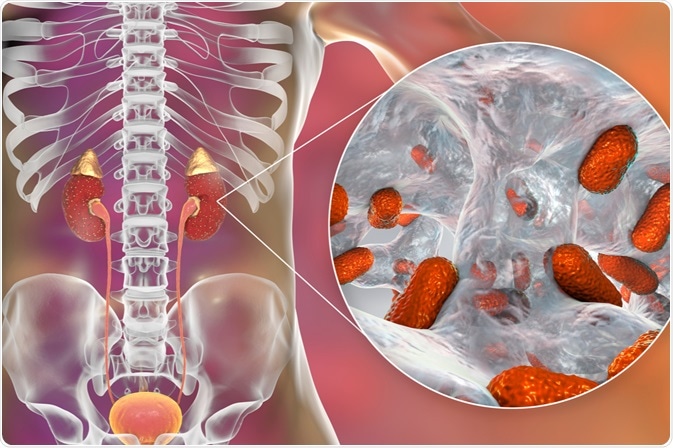Pyelonephritis is a type of urinary tract infection that affects one or both kidneys. The condition is encountered in the acute and chronic forms, with further subclassification of the latter depending on whether there is also a lower urinary tract obstruction.

Image Credit: Kateryna Kon / Shutterstock
Pathogenesis of the disease
Ascending route of infection is the underlying cause found in the cases of acute pyelonephritis. Conditions that contribute to contamination of urine in the bladder include sex (short urethra in infant girls), age, poor personal hygiene, instrumentation and other potential factors.
Vesicoureteral reflux (VUR) can be found in a significant number of young girls with urinary tract infections. This can further contribute to the retrograde spread of bacteria from the bladder to the kidney. The etiologic agent is Escherichia coli in more than 80% of cases of acute pyelonephritis, but other Gram-positive and Gram-negative bacteria can be found in some instances.
Hematogenous acute pyelonephritis is most often diagnosed in incapacitated and chronically ill patients, but also in those receiving immunosuppressive therapy. Fungal and staphylococcal infections may sometimes spread to the kidney from distant foci in the bone or skin.
The pathogenesis of chronic pyelonephritis is more complex and related to anatomical features of the malpighian pyramids (triangular sections of tissue that constitute the inner substance of the kidney). Two clinical forms of chronic pyelonephritis are recognized: obstructive pyelonephritis and reflux pyelonephritis.
Chronic pyelonephritis usually affects patients that are predisposed to urinary reflux into the renal pelvis (by VUR, obstructive uropathy or struvite calculi). The renal scars of chronic non-obstructive pyelonephritis are more commonly found at the poles of the kidney, while scars attributable to the obstructive form of chronic pyelonephritis are more extensive throughout the kidney.
Pathologic specificities
Typical gross features of acute pyelonephritis that can be observed at the autopsy are punctate abscesses present on both the cortical and cut surfaces of the kidney (with an apparent predilection for the cortex). They are outlined by a thin red margin that corresponds to marginal vascular dilatation.
A large number of neutrophils with fewer lymphocytes can be found during the microscopic observation of the abscesses. The patchy distribution of pronounced inflammatory foci with intervening areas of normal renal parenchyma is a hallmark of acute pyelonephritis. Pyonephrosis and perinephric abscess are possible complications of acute pyelonephritis.
Principal pathological features of chronic pyelonephritis are patchy cortical scars related to enlarged and distorted subjacent calyces. A parenchymal loss between the scar and the distorted calyx can be observed, which is often accompanied by variable loss of a corticomedullary junction.
Interstitial fibrosis with nephron atrophy and destruction (and sometimes periglomerular fibrosis) can be seen microscopically. The calyceal mucosa typically contains an intense lymphocytic infiltrate, while tubular segments are dilated and atrophic.
Sources
- http://www.aafp.org/afp/2005/0301/p933.html
- http://www.aafp.org/afp/2011/0901/p519.pdf
- http://pubs.rsna.org/doi/full/10.1148/rg.281075171
- https://www.niddk.nih.gov/
- Crutchlow EM, Dudac PJ, MacAvoy S, Madara BR. Pathophysiology. Jones & Bartlett Learning, 2002; pp. 222-245.
- Jennette JC. The Kidney. In: Rubin E, Reisner HM. Essentials of Rubin's Pathology. Lippincott Williams & Wilkins, 2009; pp. 350-374.
Further Reading